Research on the Multi-Equipment Cooperative Scheduling Method of Sea-Rail Automated Container Terminals under the Loading and Unloading Mode
Abstract
:1. Introduction
- (1)
- This study is the first to investigate the collaborative scheduling problem under the loading and unloading mode in SRACTs, filling a research gap in this domain and holding immense practical significance for the construction and operation of SRACTs.
- (2)
- Six container flows and seven AGV flows under the loading and unloading mode are proposed, offering clear operational guidance and a classification system for collaborative scheduling within SRACTs.
- (3)
- Based on the flow classification, a mathematical model for multi-device cooperative scheduling under the loading and unloading mode in SRACTs is established, and a heuristic algorithm is devised to obtain approximate optimal solutions for the model without pursuing the exact optimal solution.
- (4)
- In the face of common real-world scenarios such as delayed arrival of ships and variations in the types of containers on trains, AGV adjustment strategies are designed to meet the actual scheduling needs of SRACTs, enhancing the practicality of the research.
2. Literature Review
2.1. Scheduling Study of AGVs and YCs in Automated Container Terminals
2.2. Equipment Scheduling at Sea-Rail Terminals
2.3. Research Overview
- (1)
- Most research has been focused on single scenarios of automated terminals or railway operation areas, failing to fully reflect the strong coupling between port operations and railway operations. There is a need to investigate the interrelations between multiple devices involved in SRACTs, with a focus on the flow direction of containers and vehicles.
- (2)
- Existing studies on sea-rail intermodal collaborative scheduling have only considered train unloading modes, lacking research on loading modes, thereby failing to comprehensively reflect the operation process at SRACTs. Thus, it is necessary to consider both unloading and loading operations of trains in the multi-device collaborative scheduling method for SRACTs, given complex container and vehicle flows, to enhance the overall production efficiency of these terminals.
3. Model Establishment
3.1. Analysis of the Operation Process of the SRACT
3.2. Collaborative Scheduling Optimization Model for Multiple Equipment
3.2.1. Basic Assumptions
- All the containers discussed are standard 40-foot containers.
- The AGVs, YCs, and RGCs can and should only handle one task at a time.
- The travel speed and energy consumption of the AGVs, as well as the movement speed of the RGCs’ gantry and spreader, are assumed to be constant.
- The transit time for the RGCs’ spreader to travel vertically between the top and bottom is considered to be a fixed value.
- The capacity of the YCs’ buffering brackets is set to be a consistent value.
- The operation time of AGVs under the QC and the time taken for the lifting gears of YCs and RGCs to pick up and place containers from the AGVs are not counted.
3.2.2. Symbol Description
Set
| Set of RGCs, | |
| Set of AGVs, | |
| Set of QCs, | |
| Set of Ycs, | |
| Set of train wagons, | |
| Set of Train-Ship tasks, | |
| Set of Train-Yard tasks, | |
| Set of unloading tasks, | |
| Set of containers requiring temporary storage, | |
| Set of Yard-Train tasks, | |
| Set of train tasks, | |
| Virtual start task of the train, | |
| Virtual end task of the train, | |
| Set of Ship-Yard tasks, | |
| Set of tasks that cannot be operated by RGCs simultaneously, |
Parameters
| Energy consumption of one RGC’s gantry, unit: kWh/h | |
| Energy consumption of one RGC’s spreader, unit: kWh/h | |
| Energy consumption of one RGC’s waiting, unit: kWh/h | |
| Energy consumption of one AGV under loaded condition, unit: kWh/h | |
| Energy consumption of one AGV under unloaded condition, unit: kWh/h | |
| Energy consumption of one AGV’s waiting, unit: kWh/h | |
| Total energy consumption of RGCs | |
| Total energy consumption of AGVs | |
| Moving speed of RGC’s spreader | |
| Unloaded moving speed of AGVs | |
| Loaded moving speed of AGVs | |
| Time for RGC’s spreader to move one wagon bay | |
| Average operation time for RGCs to place containers from temporary storage to AGVs | |
| Average operation time for Ycs to handle one container | |
| Time for the RGC’s spreader to rise/fall | |
| Capacity of yard buffer stands | |
| Loading and unloading line position of task | |
| Bay position of the wagon for task | |
| Moving distance of RGC ’s spreader from the loading/unloading line of task to the AGV operating lane above | |
| Distance for RGC to move from the loading/unloading line of task to the temporary storage area | |
| Safety distance of RGC | |
| An infinitely large integer | |
| Weight coefficient of completion time of loading/unloading | |
| Weight coefficient of total energy consumption of equipment | |
| Ship’s arrival time | |
| The earliest time AGV can pick up/drop off task at the buffer stand under the container area of YC | |
| The latest time AGV can pick up/drop off task at the buffer stand under the container area of YC | |
| Distance from equipment to equipment |
Non 0–1 Variables
| Time when RGC starts task | |
| Time when RGC ’s spreader moves to the AGV operating lane above task | |
| Time when RGC starts interacting with AGV for task | |
| Time when RGC completes task , i.e., time when RGC loads task onto the AGV or time when RGC loads task onto the train | |
| Time when AGV arrives under YC during task | |
| Time when AGV arrives under RGC during task | |
| Time when AGV arrives under QC during task | |
| The earliest time AGV can pick up/drop off task at the buffer stand under the container area of YC | |
| The latest time AGV can pick up/drop off task at the buffer stand under the container area of YC | |
| Time when AGV completes task | |
| Number of containers stored in temporary storage area bay b when RGC is operating task | |
| Transversal movement time of RGC ’s spreader during task | |
| Loaded time of AGV during task | |
| Empty time of AGV after task and before task | |
| Time for RGC to wait for AGV during task | |
| Time for YC to wait for AGV during task | |
| Time for AGV to wait for RGC during task | |
| Time for AGV to wait for YC during task | |
| Time for AGV to transport task from RGC to YC /Time for AGV to transport task from YC to RGC | |
| Time for AGV to transport task from RGC to QC | |
| Time for AGV to transport task from QC to YC | |
| Time for AGV to travel to QC to pick up task after completing task at QC | |
| Time for AGV to travel to RGC to pick up task after completing task at YC | |
| Time for AGV to travel to RGC to pick up task after completing task at RGC | |
| Utilization rate of AGV | |
| Total loaded time of AGV | |
| Total operating time of AGV |
0–1 Variables
| When RGC operates task , , otherwise | |
| When AGV operates task , , otherwise | |
| When RGC operates task and continues to task , , otherwise | |
| When AGV operates tasks and consecutively, , otherwise | |
| When YC operates tasks and consecutively, , otherwise | |
| When task is operated by RGC and AGV , , otherwise | |
| When task is operated by AGV and YC , , otherwise | |
| When task is operated by AGV and QC , , otherwise | |
| When RGC operates task in the temporary storage area, , otherwise |
3.3. Cooperative Scheduling Model of RGCs, AGVs, and YCs
4. Self-Adaptive Chaotic Genetic Algorithm
4.1. Encoding and Decoding
4.2. Select Operation
4.3. Crossover and Mutation Operations
4.4. Chaos Optimization
4.5. Gene Repair
4.6. Algorithm Stopping Rules
5. Simulation Experiments and Analysis
5.1. Algorithm Validity Verification Experiment
5.2. Experiment on Comparing Bi-Objective and Single-Objective Optimizatiom
5.3. Normalization and the Impact of Weights
5.4. Optimization of RGCs, AGVs, and YCs Configurations Experiments
5.5. Impact of Vessel Delays and Container Type Change
6. Conclusions
Author Contributions
Funding
Data Availability Statement
Conflicts of Interest
References
- Millefiori, L.M.; Braca, P.; Zissis, D.; Spiliopoulos, G.; Marano, S.; Willett, P.K.; Carniel, S. COVID-19 impact on global maritime mobility. Sci. Rep. 2021, 11, 18039. [Google Scholar] [CrossRef]
- Yang, Y.; Zhong, M.; Dessouky, Y.; Postolache, O. An integrated scheduling method for AGV routing in automated container terminals. Comput. Ind. Eng. 2018, 126, 482–493. [Google Scholar] [CrossRef]
- Yu, H.; Huang, M.; He, J.; Tan, C. The clustering strategy for stacks allocation in automated container terminals. Marit. Policy Manag. 2022, 1–16. [Google Scholar] [CrossRef]
- Chang, Y.; Zhu, X.; Haghani, A. Modeling and solution of joint storage space allocation and handling operation for outbound containers in rail-water intermodal container terminals. IEEE Access 2019, 7, 55142–55158. [Google Scholar] [CrossRef]
- Reis, V.; Meier, J.F.; Pace, G.; Palacin, R. Rail and multi-modal transport. Res. Transp. Econ. 2013, 41, 17–30. [Google Scholar] [CrossRef]
- Boysen, N.; Fliedner, M.; Jaehn, F.; Pesch, E. A survey on container processing in railway yards. Transp. Sci. 2013, 47, 312–329. [Google Scholar] [CrossRef]
- Yang, Y.; He, S.; Sun, S. Research on the Cooperative Scheduling of ARMGs and AGVs in a Sea–Rail Automated Container Terminal under the Rail-in-Port Model. J. Mar. Sci. Eng. 2023, 11, 557. [Google Scholar] [CrossRef]
- Li, J.; Yan, L.; Xu, B. Research on Multi-Equipment Cluster Scheduling of U-Shaped Automated Terminal Yard and Railway Yard. J. Mar. Sci. Eng. 2023, 11, 417. [Google Scholar] [CrossRef]
- Wang, L.; Zhu, X. Rail mounted gantry crane scheduling optimization in railway container terminal based on hybrid handling mode. Comput. Intell. Neurosci. 2014, 2014, 682486. [Google Scholar] [CrossRef]
- Li, W.; Du, S.; Zhong, L.; He, L. Multiobjective Scheduling for Cooperative Operation of Multiple Gantry Cranes in Railway Area of Container Terminal. IEEE Access 2022, 10, 46772–46781. [Google Scholar] [CrossRef]
- Fu, X.; Yang, Y. Modeling and analyzing cascading failures for Internet of Things. Inf. Sci. 2021, 545, 753–770. [Google Scholar] [CrossRef]
- Fu, X.; Yang, Y. Analysis on invulnerability of wireless sensor networks based on cellular automata. Reliab. Eng. Syst. Saf. 2021, 212, 107616. [Google Scholar] [CrossRef]
- Fu, X.; Li, Q.; Li, W. Modeling and analysis of industrial IoT reliability to cascade failures: An information-service coupling perspective. Reliab. Eng. Syst. Saf. 2023, 239, 109517. [Google Scholar] [CrossRef]
- Chen, X.; Wu, S.; Shi, C.; Huang, Y.; Yang, Y.; Ke, R.; Zhao, J. Sensing Data Supported Traffic Flow Prediction via Denoising Schemes and ANN: A Comparison. IEEE Sens. J. 2020, 20, 14317–14328. [Google Scholar] [CrossRef]
- Iris, Ç.; Christensen, J.; Pacino, D.; Ropke, S. Flexible ship loading problem with transfer vehicle assignment and scheduling. Transp. Res. Part B Methodol. 2018, 111, 113–134. [Google Scholar] [CrossRef]
- Zhou, C.; Zhu, S.; Bell, M.G.H.; Lee, L.H.; Chew, E.P. Emerging technology and management research in the container terminals: Trends and the COVID-19 pandemic impacts. Ocean Coast. Manag. 2022, 230, 106318. [Google Scholar] [CrossRef]
- Iris, Ç.; Lam, J.S.L. A review of energy efficiency in ports: Operational strategies, technologies and energy management systems. Renew. Sustain. Energy Rev. 2019, 112, 170–182. [Google Scholar] [CrossRef]
- Wu, Y.; Li, W.; Petering, M.E.H.; Goh, M.; de Souza, R. Scheduling multiple yard cranes with crane interference and safety distance requirement. Transp. Sci. 2015, 49, 990–1005. [Google Scholar] [CrossRef]
- Chu, F.; He, J.; Zheng, F.; Liu, M. Scheduling multiple yard cranes in two adjacent container blocks with position-dependent processing times. Comput. Ind. Eng. 2019, 136, 355–365. [Google Scholar] [CrossRef]
- Sha, M.; Zhang, T.; Lan, Y.; Zhou, X.; Qin, T.; Yu, D.; Chen, K. Scheduling optimization of yard cranes with minimal energy consumption at container terminals. Comput. Ind. Eng. 2017, 113, 704–713. [Google Scholar] [CrossRef]
- Chen, X.; Wang, Z.; Hua, Q.; Shang, W.-L.; Luo, Q.; Yu, K. AI-Empowered Speed Extraction via Port-Like Videos for Vehicular Trajectory Analysis. IEEE Trans. Intell. Transp. Syst. 2023, 24, 4541–4552. [Google Scholar] [CrossRef]
- Zhong, M.; Yang, Y.; Dessouky, Y.; Postolache, O. Multi-AGV scheduling for conflict-free path planning in automated container terminals. Comput. Ind. Eng. 2020, 142, 106371. [Google Scholar] [CrossRef]
- Hu, H.; Yang, X.; Xiao, S.; Wang, F. Anti-conflict AGV path planning in automated container terminals based on multi-agent reinforcement learning. Int. J. Prod. Res. 2023, 61, 65–80. [Google Scholar] [CrossRef]
- Kim, K.H.; Lee, K.M.; Hwang, H. Sequencing delivery and receiving operations for yard cranes in port container terminals. Int. J. Prod. Econ. 2003, 84, 283–292. [Google Scholar] [CrossRef]
- Lee, B.K.; Kim, K.H. Comparison and evaluation of various cycle-time models for yard cranes in container terminals. Int. J. Prod. Econ. 2010, 126, 350–360. [Google Scholar] [CrossRef]
- Liu, W.; Zhu, X.; Wang, L.; Li, S. Rolling horizon based robust optimization method of quayside operations in maritime container ports. Ocean Eng. 2022, 256, 111505. [Google Scholar] [CrossRef]
- Zheng, F.; Man, X.; Chu, F.; Liu, M.; Chu, C. Two yard crane scheduling with dynamic processing time and interference. IEEE Trans. Intell. Transp. Syst. 2018, 19, 3775–3784. [Google Scholar] [CrossRef]
- Nossack, J.; Briskorn, D.; Pesch, E. Container dispatching and conflict-free yard crane routing in an automated container terminal. Transp. Sci. 2018, 52, 1059–1076. [Google Scholar] [CrossRef]
- Eilken, A. A decomposition-based approach to the scheduling of identical automated yard cranes at container terminals. J. Sched. 2019, 22, 517–541. [Google Scholar] [CrossRef]
- Lu, H.; Wang, S. A study on multi-ASC scheduling method of automated container terminals based on graph theory. Comput. Ind. Eng. 2019, 129, 404–416. [Google Scholar] [CrossRef]
- Zhang, Q.; Hu, W.; Duan, J.; Qin, J. Cooperative Scheduling of AGV and ASC in Automation Container Terminal Relay Operation Mode. Math. Probl. Eng. 2021, 2021, 5764012. [Google Scholar] [CrossRef]
- Yang, X.-M.; Jiang, X.-J. Yard Crane Scheduling in the Ground Trolley-Based Automated Container Terminal. Asia-Pac. J. Oper. Res. 2020, 37, 2050007. [Google Scholar] [CrossRef]
- Chen, X.; He, S.; Zhang, Y.; Tong, L.; Shang, P.; Zhou, X. Yard crane and AGV scheduling in automated container terminal: A multi-robot task allocation framework. Transp. Res. Part C Emerg. Technol. 2020, 114, 241–271. [Google Scholar] [CrossRef]
- Hsu, H.-P.; Tai, H.-H.; Wang, C.-N.; Chou, C.-C. Scheduling of collaborative operations of yard cranes and yard trucks for export containers using hybrid approaches. Adv. Eng. Inform. 2021, 48, 101292. [Google Scholar] [CrossRef]
- Zhou, C.; Lee, B.K.; Li, H. Integrated optimization on yard crane scheduling and vehicle positioning at container yards. Transp. Res. E Logist. Transp. Rev. 2020, 138, 101966. [Google Scholar] [CrossRef]
- Peng, Y.; Wang, W.; Liu, K.; Li, X.; Tian, Q. The impact of the allocation of facilities on reducing carbon emissions from a green container terminal perspective. Sustainability 2018, 10, 1813. [Google Scholar] [CrossRef]
- Li, X.; Peng, Y.; Huang, J.; Wang, W.; Song, X. Simulation study on terminal layout in automated container terminals from efficiency, economic and environment perspectives. Ocean Coast. Manag. 2021, 213, 105882. [Google Scholar] [CrossRef]
- Zhao, Q.; Ji, S.; Zhao, W.; De, X. A Multilayer Genetic Algorithm for Automated Guided Vehicles and Dual Automated Yard Cranes Coordinated Scheduling. Math. Probl. Eng. 2020, 2020, 5637874. [Google Scholar] [CrossRef]
- Iris, Ç.; Lam, J.S.L. Optimal energy management and operations planning in seaports with smart grid while harnessing renewable energy under uncertainty. Omega 2021, 103, 102445. [Google Scholar] [CrossRef]
- Ballis, A.; Golias, J. Comparative evaluation of existing and innovative rail–road freight transport terminals. Transp. Res. Part A Policy Pract. 2002, 36, 593–611. [Google Scholar] [CrossRef]
- Li, X.; Otto, A.; Pesch, E. Solving the single crane scheduling problem at rail transshipment yards. Discret. Appl. Math. 2018, 264, 134–147. [Google Scholar] [CrossRef]
- Ren, G.; Wang, X.; Cai, J.; Guo, S. Allocation and scheduling of handling resources in the railway container terminal based on crossing crane area. Sustainability 2021, 13, 1190. [Google Scholar] [CrossRef]
- Yan, B.; Zhu, X.; Wang, L.; Chang, Y. Integrated Scheduling of Rail-Mounted Gantry Cranes, Internal Trucks and Reach Stackers in Railway Operation Area of Container Terminal. Transp. Res. Rec. 2018, 2672, 47–58. [Google Scholar] [CrossRef]
- Chang, Y.; Zhu, X.; Yan, B.; Wang, L. Integrated scheduling of handling operations in railway container terminals. Transp. Lett. 2019, 11, 402–412. [Google Scholar] [CrossRef]
- Iris, Ç.; Pacino, D.; Ropke, S. Improved formulations and an Adaptive Large Neighborhood Search heuristic for the integrated berth allocation and quay crane assignment problem. Transp. Res. E Logist. Transp. Rev. 2017, 105, 123–147. [Google Scholar] [CrossRef]
- El Aziz, M.A.; Ewees, A.A.; Hassanien, A.E. Multi-objective whale optimization algorithm for content-based image retrieval. Multimed. Tools Appl. 2018, 77, 26135–26172. [Google Scholar] [CrossRef]
- Bao, X.; Xiong, Z.; Zhang, N.; Qian, J.; Wu, B.; Zhang, W. Path-oriented test cases generation based adaptive genetic algorithm. PLoS ONE 2017, 12, e0187471. [Google Scholar] [CrossRef]
- Zheng, Y.; Li, Y.; Wang, G.; Chen, Y.; Xu, Q.; Fan, J.; Cui, X. A Novel Hybrid Algorithm for Feature Selection Based on Whale Optimization Algorithm. IEEE Access 2019, 7, 14908–14923. [Google Scholar] [CrossRef]
- Dehkordi, A.A.; Sadiq, A.S.; Mirjalili, S.; Ghafoor, K.Z. Nonlinear-based Chaotic Harris Hawks Optimizer: Algorithm and Internet of Vehicles application. Appl. Soft Comput. 2021, 109, 107574. [Google Scholar] [CrossRef]
- Ali, T.S.; Ali, R. A new chaos based color image encryption algorithm using permutation substitution and Boolean operation. Multimed. Tools Appl. 2020, 79, 19853–19873. [Google Scholar] [CrossRef]
- An, F.-P.; Liu, J.-E. Image Encryption Algorithm Based on Adaptive Wavelet Chaos. J. Sens. 2019, 2019, 2768121. [Google Scholar] [CrossRef]
- Zhang, L.; Zhang, X. Multiple-image encryption algorithm based on bit planes and chaos. Multimed. Tools Appl. 2020, 79, 20753–20771. [Google Scholar] [CrossRef]
- Tang, L.; Zhao, J.; Liu, J. Modeling and solution of the joint quay crane and truck scheduling problem. Eur. J. Oper. Res. 2014, 236, 978–990. [Google Scholar] [CrossRef]
- Yue, L.; Fan, H.; Zhai, C. Joint configuration and scheduling optimization of a dual-trolley quay crane and Automatic guided vehicles with consideration of vessel stability. Sustainability 2020, 12, 24. [Google Scholar] [CrossRef]
- Peng, H.; Wen, W.-S.; Tseng, M.-L.; Li, L.-L. Joint optimization method for task scheduling time and energy consumption in mobile cloud computing environment. Appl. Soft Comput. 2019, 80, 534–545. [Google Scholar] [CrossRef]
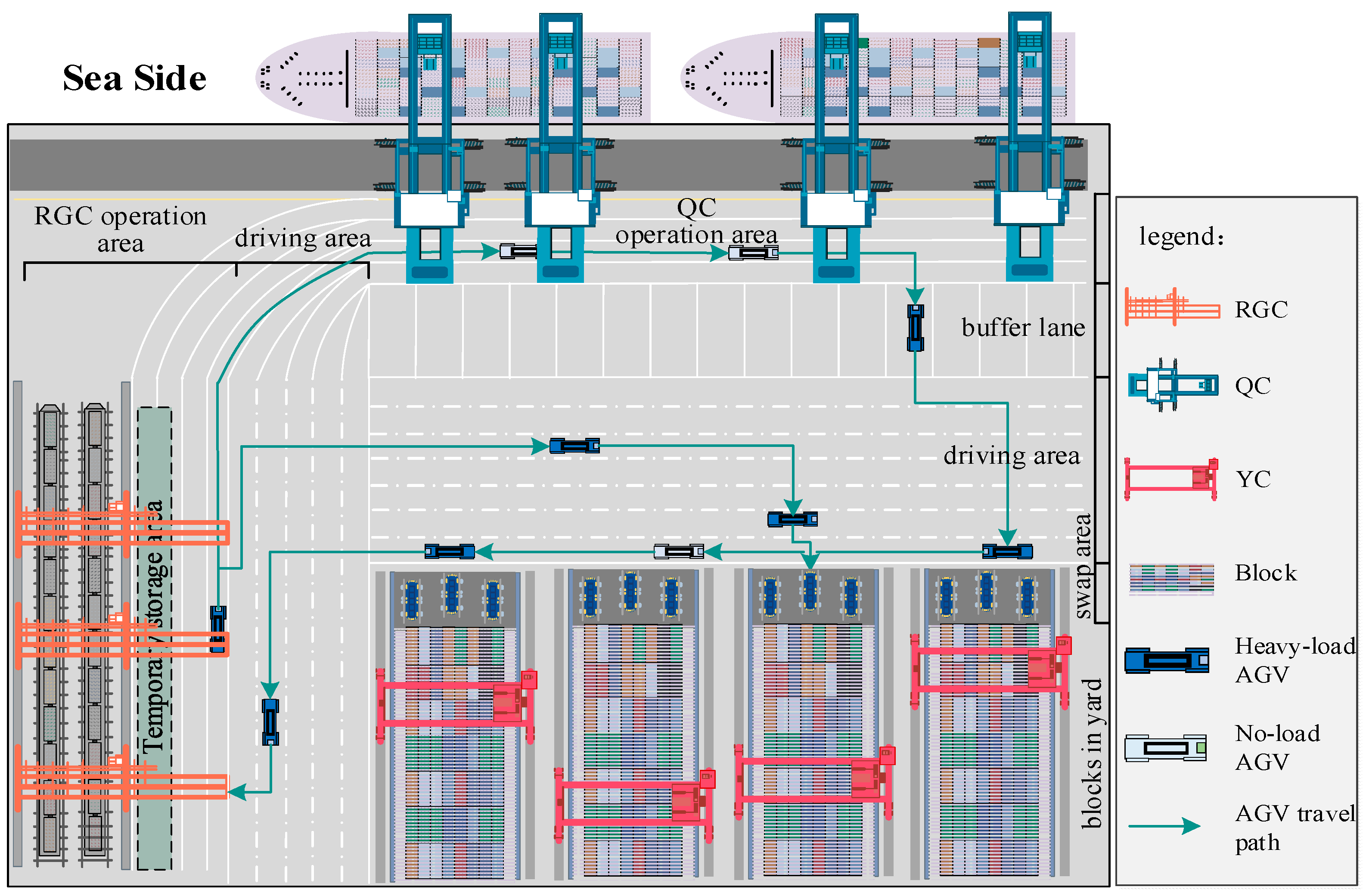
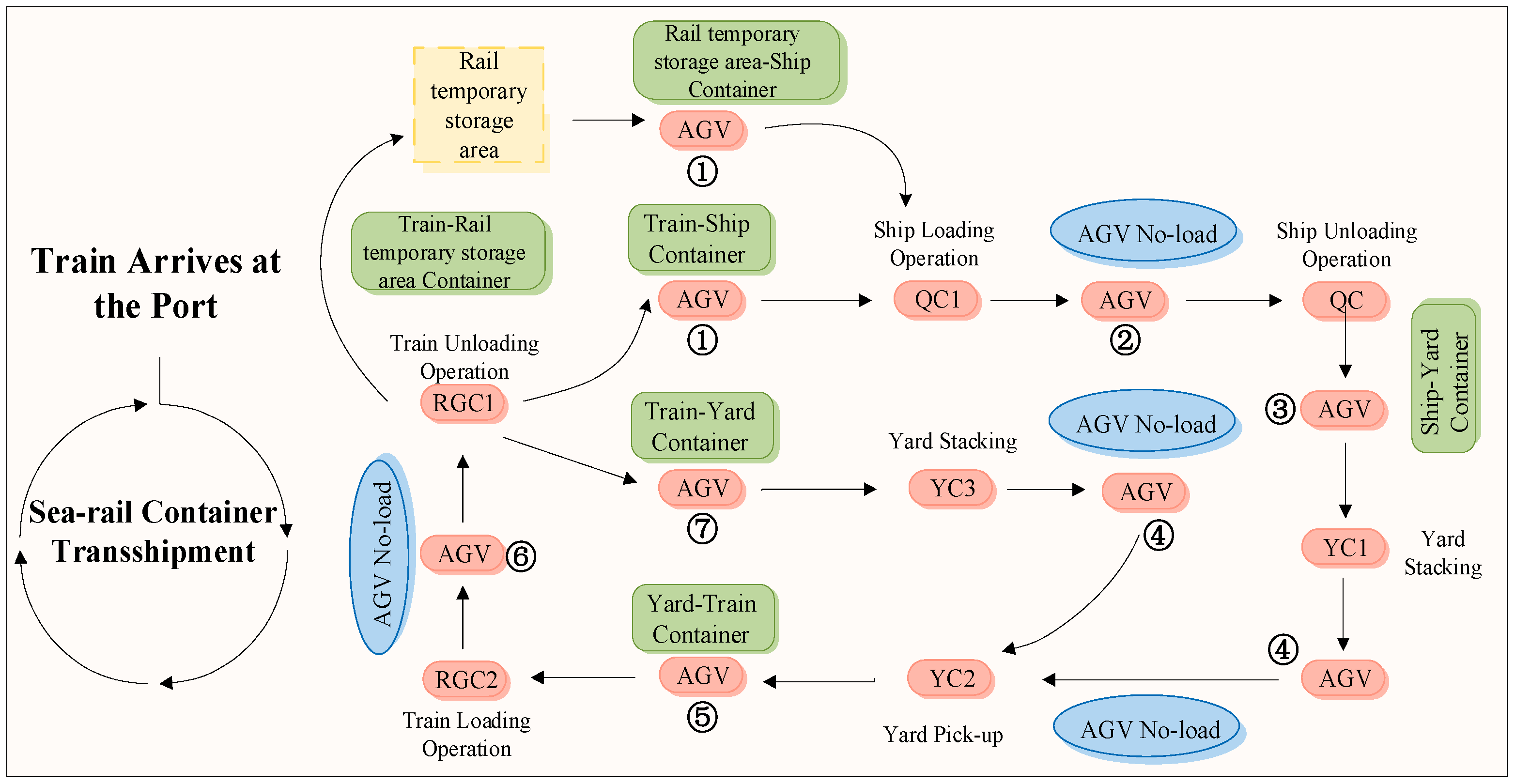
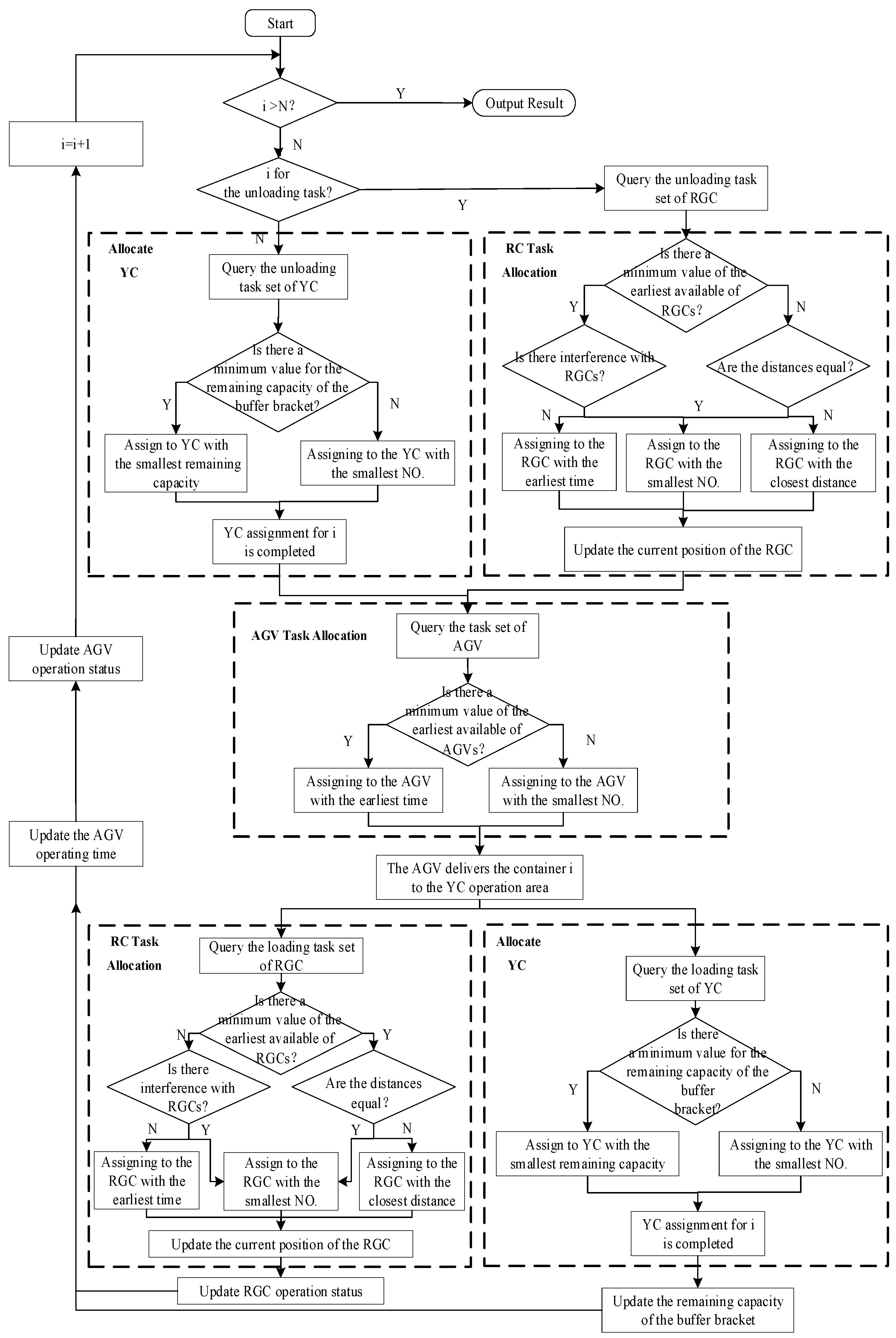


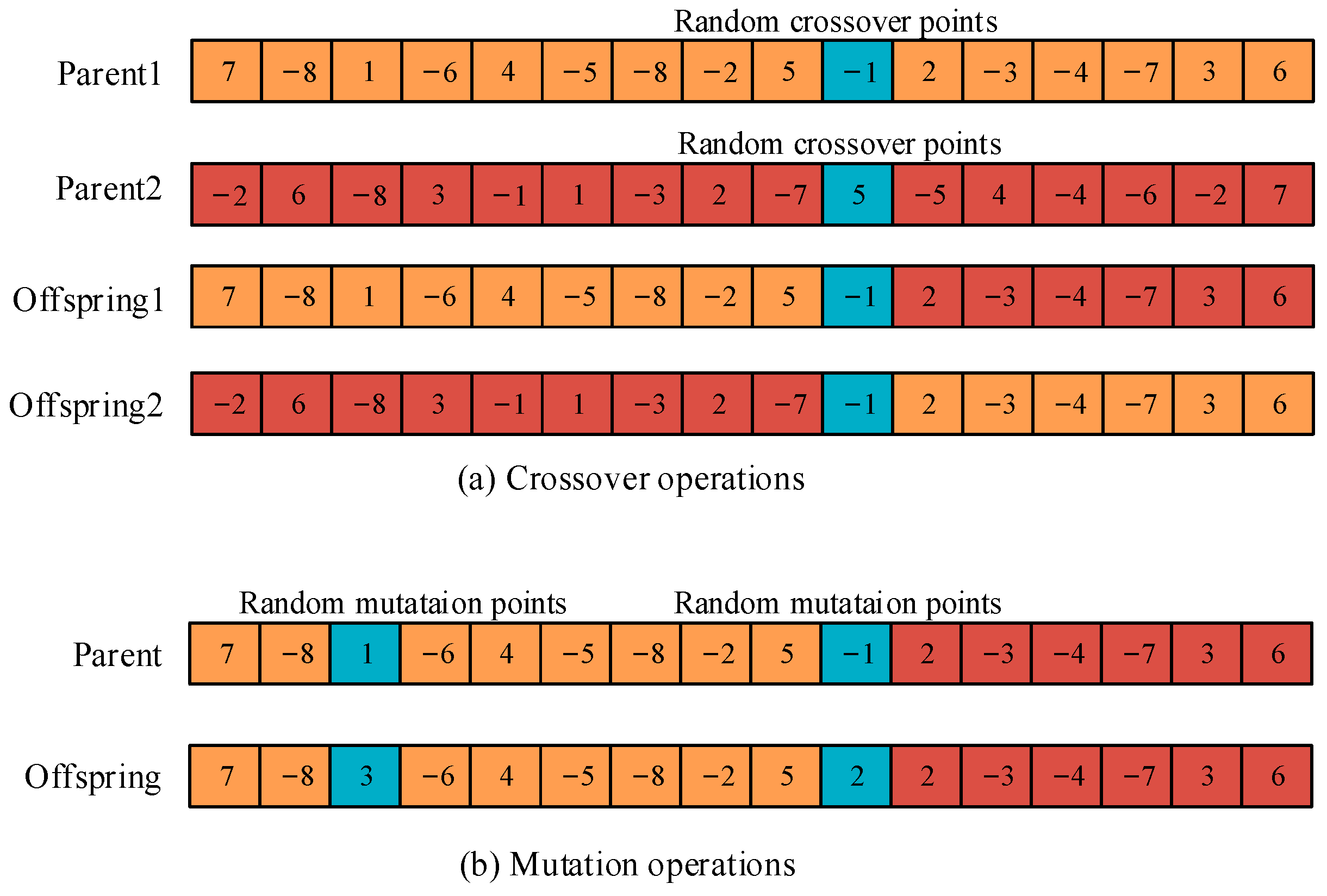


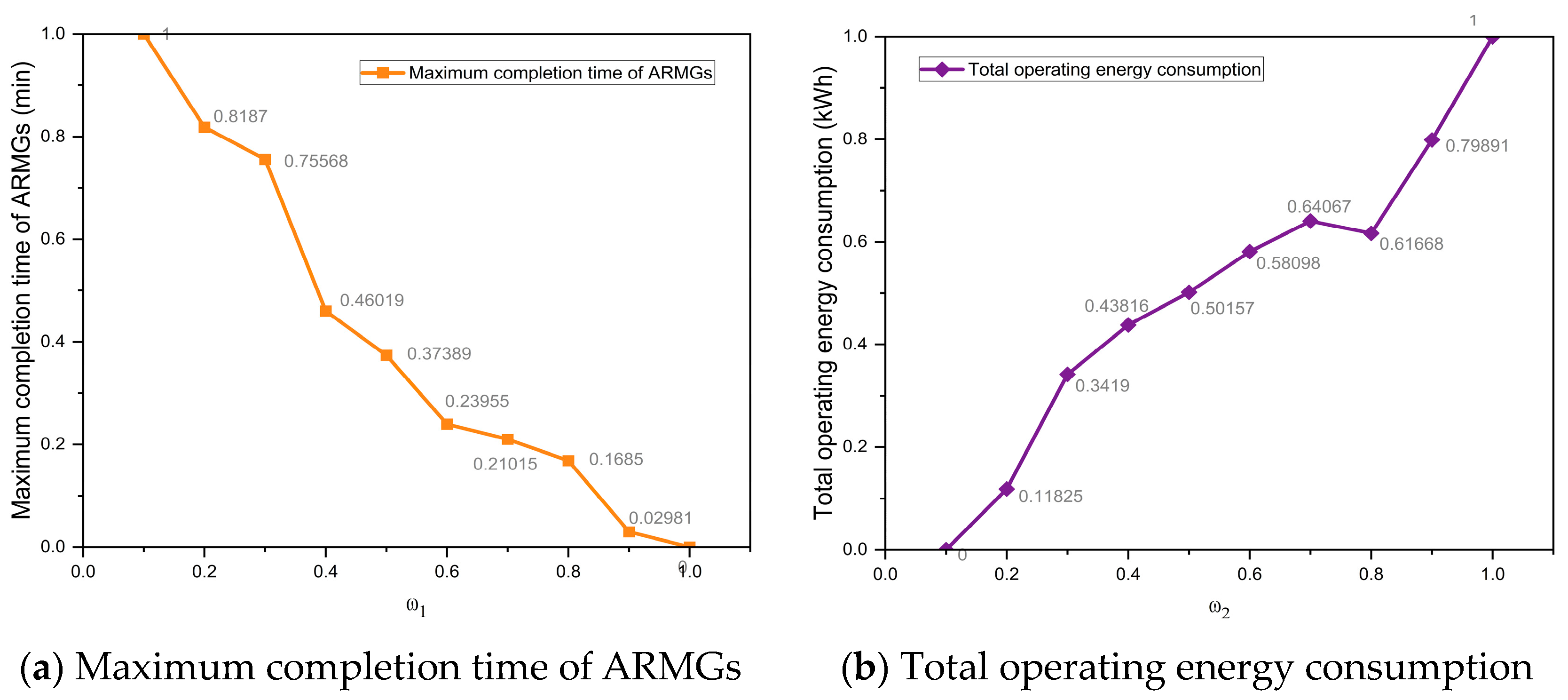
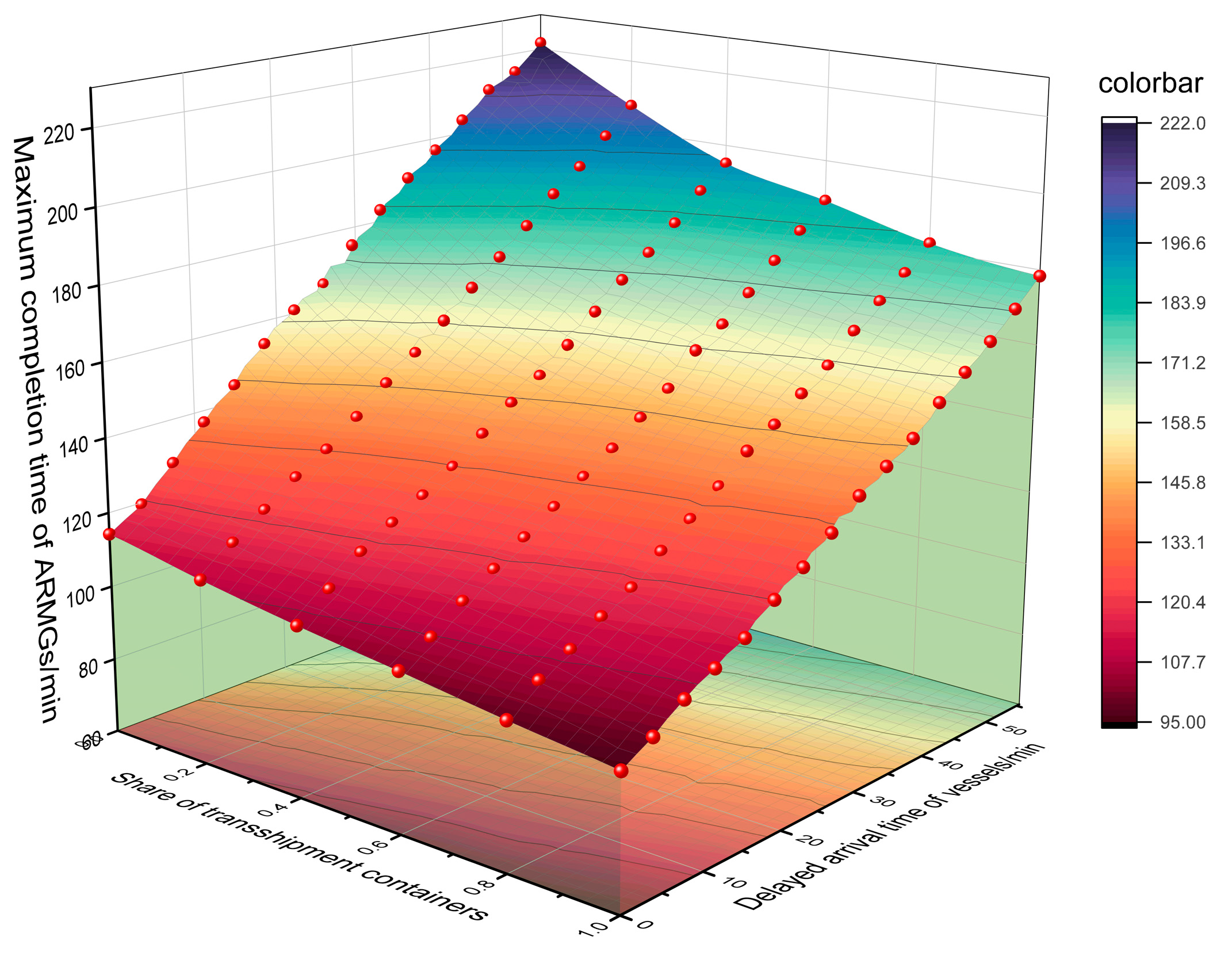
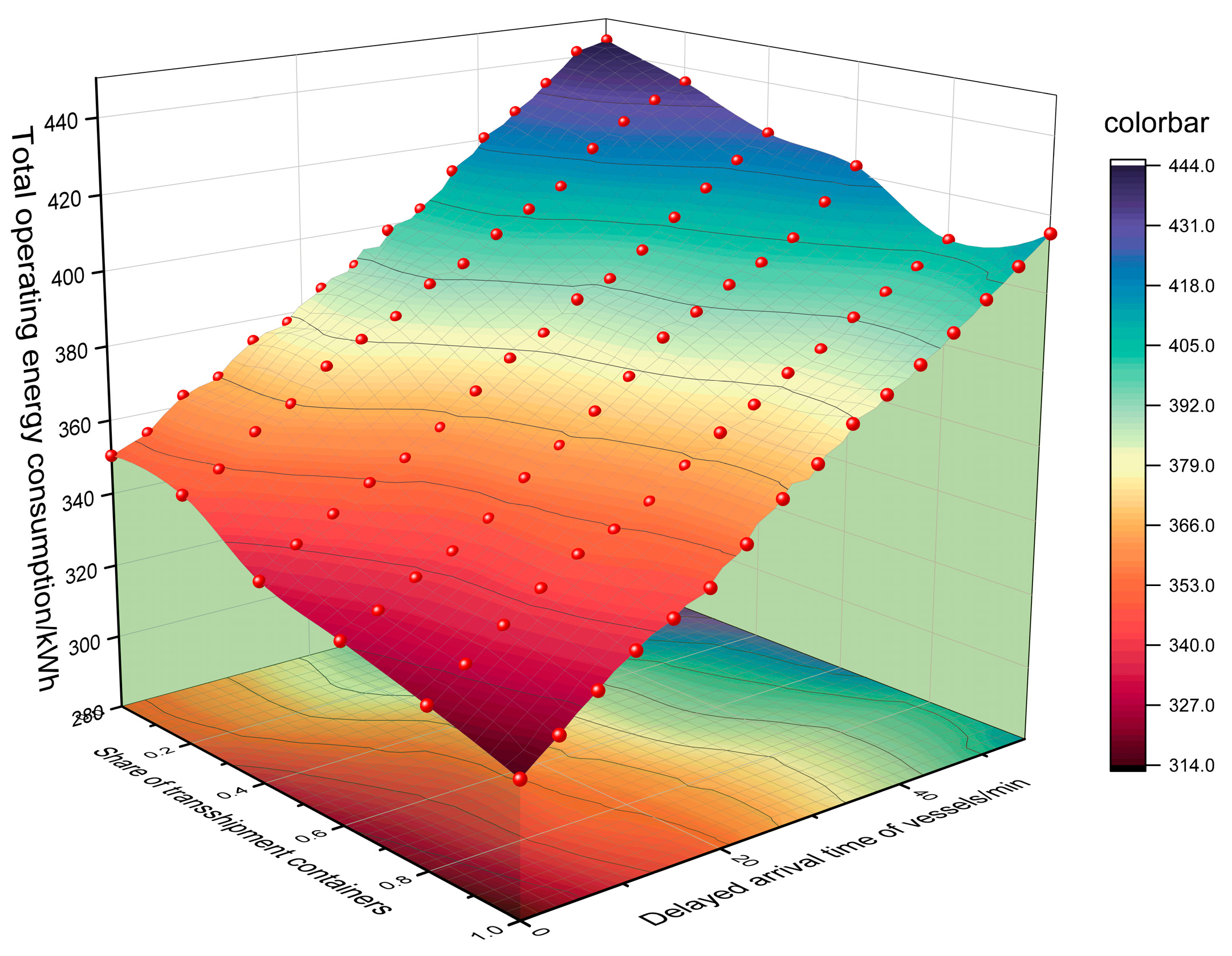
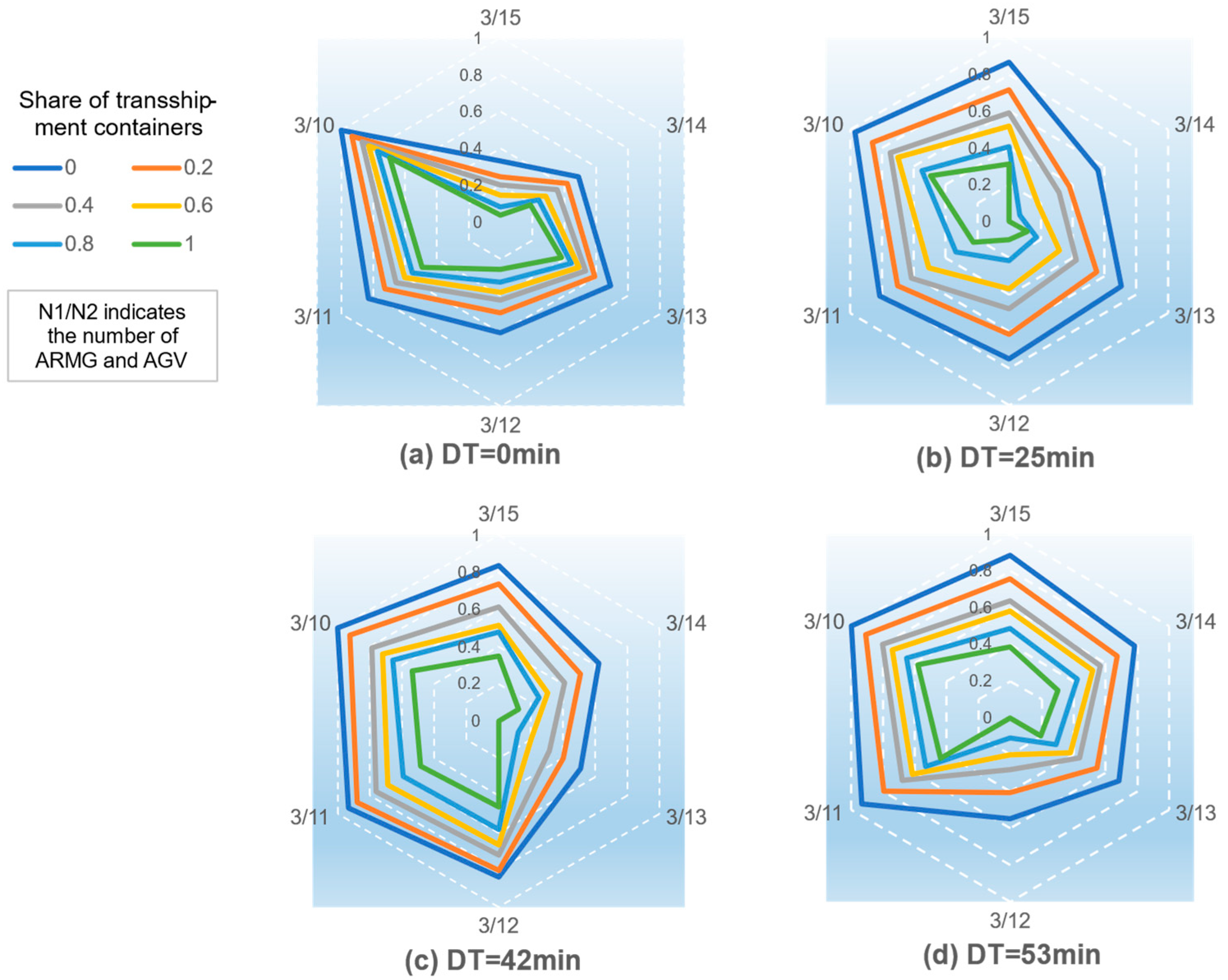
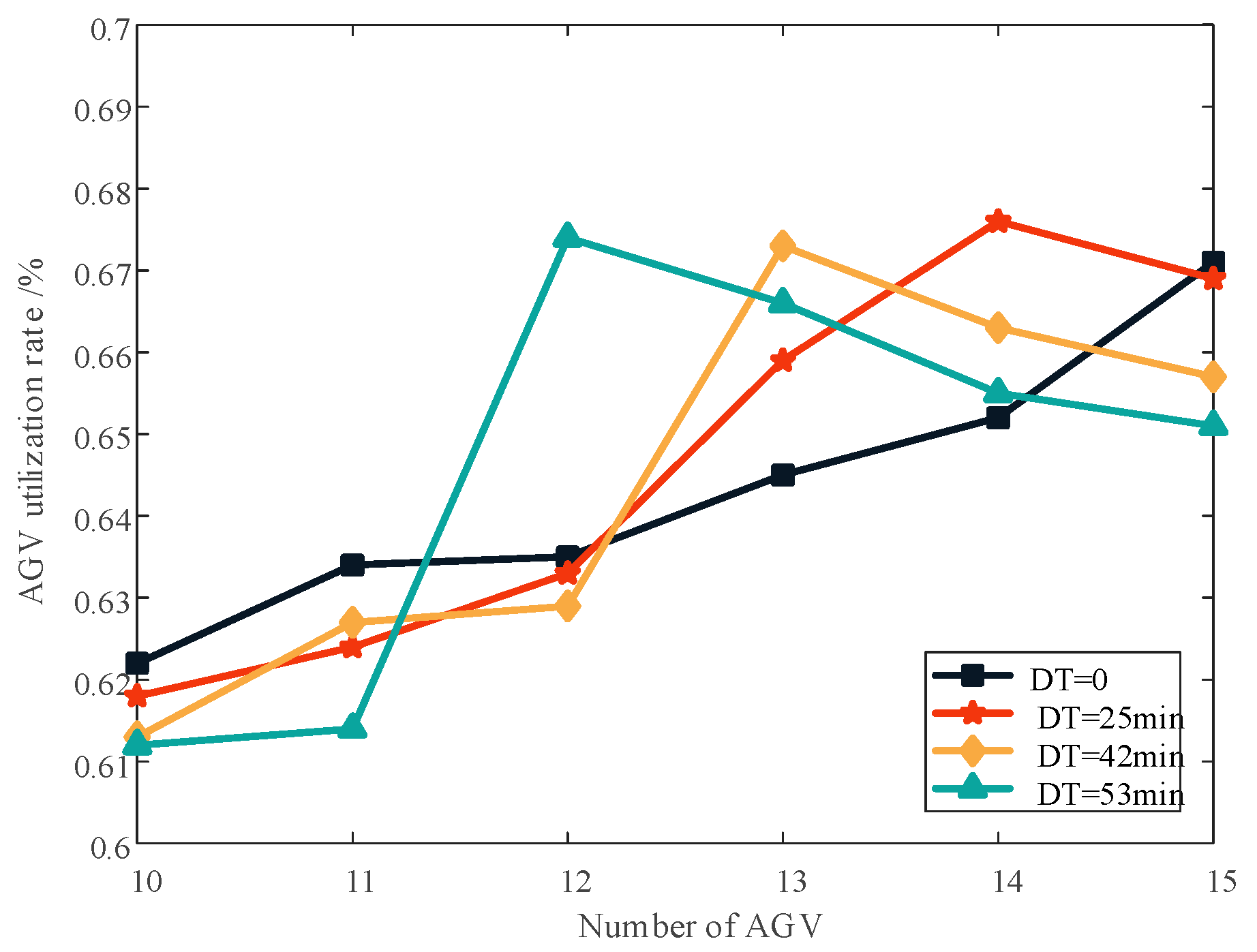
| Parameters | Numerical Values |
|---|---|
| Elevation height for the RGC | 10 m |
| Container widths | 2.5 m |
| Distance between carriages | 17 m |
| Railway loading and unloading line spacing | 2.5 m |
| Traveling speed of the RGC gantry | 80 m/min |
| Traveling speed of the RGC spreader | 85 m/min |
| Average handling time for a task by YC | 1.5 min |
| Buffer capacity of the yard | 4TEU |
| Energy consumption of one RGC gantry during operation | 30 kWh/h |
| Energy consumption of one RGC spreader during motion | 20 kWh/h |
| Waiting energy consumption of one RGC | 15 kWh/h |
| Energy consumption of one AGV with container | 21 kWh/h |
| Energy consumption of one AGV without container | 14 kWh/h |
| Safety distance between two RGCs | 1 carriage |
| Waiting energy consumption of one AGV | 9 kWh/h |
| Travel speed of the AGV with container | 210 m/min |
| Travel speed of the AGV without container | 350 m/min |
| Parameters | Value | Parameters | Value |
|---|---|---|---|
| Population size | 100 | Maximum Iterations | 500 |
| Crossover probability | [0.4, 0.9] | Mutation probability | [0.01, 0.1] |
| Crossover parameters | 0.6 | Mutation parameters | 0.05 |
| No. | N/R/V | Bi-Objective | Single-Objective | Gap1 | Gap2 | ||||||
|---|---|---|---|---|---|---|---|---|---|---|---|
| MCT/min | OEC/kWh | MCT/min | OEC/kWh | MCT (%) | OEC (%) | ||||||
| Max | Min | Mean | Max | Min | Mean | ||||||
| 1 | 10/3/4 | 21.8 | 16.9 | 18.4 | 34.6 | 28.4 | 30.1 | 20.8 | 34.9 | 11.7 | 13.8 |
| 2 | 10/3/6 | 18.4 | 12.9 | 14.5 | 25.7 | 21.5 | 22.9 | 17.0 | 27.9 | 14.9 | 18.0 |
| 3 | 15/3/4 | 35.6 | 31.2 | 31.5 | 48.7 | 44.4 | 45.2 | 32.2 | 50.4 | 2.0 | 10.3 |
| 4 | 15/3/6 | 25.7 | 21.5 | 24.2 | 40.7 | 36.3 | 37.1 | 25.7 | 40.8 | 6.2 | 9.2 |
| 5 | 20/3/4 | 39.7 | 38.0 | 38.8 | 62.3 | 61.8 | 62.0 | 39.0 | 63.2 | 0.5 | 2.0 |
| 6 | 20/3/6 | 33.9 | 29.9 | 32.7 | 52.2 | 49.1 | 50.5 | 32.8 | 53.1 | 0.2 | 4.9 |
| 7 | 30/3/6 | 57.0 | 49.8 | 52.5 | 87.9 | 84.5 | 84.7 | 53.6 | 92.9 | 2.1 | 8.8 |
| 8 | 30/3/8 | 51.5 | 46.7 | 47.9 | 85.8 | 79.9 | 81.3 | 48.4 | 90.7 | 1.0 | 10.4 |
| 9 | 40/3/6 | 61.6 | 58.9 | 60.8 | 101.3 | 96.4 | 97.5 | 64.7 | 105.4 | 6.1 | 7.5 |
| 10 | 40/3/8 | 58.5 | 53.3 | 55.7 | 95.1 | 91.5 | 91.6 | 56.6 | 99.2 | 1.7 | 7.7 |
| 11 | 50/3/8 | 81.2 | 80.0 | 80.3 | 137.9 | 134.5 | 135.4 | 83.6 | 137.9 | 4.0 | 1.8 |
| 12 | 50/3/10 | 82.9 | 77.0 | 78.2 | 136.3 | 132.4 | 132.9 | 78.7 | 137.9 | 0.6 | 3.6 |
| 13 | 100/3/10 | 136.8 | 132.8 | 135.6 | 314.8 | 308.7 | 310.4 | 138.2 | 318.7 | 1.8 | 2.6 |
| No. | R/V | MCT | OEC | CPU/s | No. | R/V | MCT | OEC | CPU/s | ||
|---|---|---|---|---|---|---|---|---|---|---|---|
| 1 | 2/4 | 348.03 | 549.36 | 1.000 | 194.5 | 21 | 3/17 | 135.88 | 363.57 | 0.086 | 197.3 |
| 2 | 2/5 | 322.56 | 538.42 | 0.913 | 195.4 | 22 | 3/18 | 137.24 | 379.02 | 0.121 | 196.4 |
| 3 | 2/6 | 287.93 | 465.98 | 0.680 | 190.4 | 23 | 4/8 | 224.05 | 484.84 | 0.554 | 193.4 |
| 4 | 2/7 | 257.83 | 444.1 | 0.559 | 191.0 | 24 | 4/9 | 210.17 | 471.17 | 0.491 | 190.2 |
| 5 | 2/8 | 241.07 | 393.56 | 0.416 | 192.7 | 25 | 4/10 | 193.7 | 454.72 | 0.416 | 189.6 |
| 6 | 2/9 | 222.4 | 408.83 | 0.398 | 193.2 | 26 | 4/11 | 187.36 | 418.67 | 0.328 | 201.2 |
| 7 | 2/10 | 219.23 | 423.14 | 0.419 | 192.3 | 27 | 4/12 | 184.85 | 403.19 | 0.291 | 192.1 |
| 8 | 2/11 | 221.4 | 432.98 | 0.444 | 193.9 | 28 | 4/13 | 176.48 | 390.34 | 0.244 | 203.0 |
| 9 | 2/12 | 222.75 | 438.36 | 0.458 | 194.6 | 29 | 4/14 | 171.64 | 378.71 | 0.208 | 194.3 |
| 10 | 3/6 | 213.82 | 428.32 | 0.415 | 190.4 | 30 | 4/15 | 167.29 | 367.14 | 0.174 | 194.8 |
| 11 | 3/7 | 198.71 | 407.12 | 0.334 | 199.0 | 31 | 4/16 | 166.07 | 366.75 | 0.170 | 195.4 |
| 12 | 3/8 | 188.47 | 398.81 | 0.291 | 203.7 | 32 | 4/17 | 163.68 | 368.51 | 0.168 | 197.7 |
| 13 | 3/9 | 174.08 | 386.14 | 0.229 | 197.1 | 33 | 4/18 | 160.1 | 369.01 | 0.159 | 193.8 |
| 14 | 3/10 | 162.74 | 372.51 | 0.173 | 202.8 | 34 | 4/19 | 156.39 | 372.67 | 0.157 | 195.2 |
| 15 | 3/11 | 153.4 | 363.57 | 0.131 | 198.3 | 35 | 4/20 | 152.75 | 375.56 | 0.154 | 196.8 |
| 16 | 3/12 | 144.09 | 348.02 | 0.077 | 193.2 | 36 | 4/21 | 153.68 | 386.18 | 0.177 | 196.4 |
| 17 | 3/13 | 144.6 | 357.33 | 0.096 | 193.0 | 37 | 4/22 | 157.02 | 398.7 | 0.210 | 202.7 |
| 18 | 3/14 | 132.49 | 348.17 | 0.047 | 197.0 | 38 | 4/23 | 157.81 | 402.8 | 0.221 | 197.9 |
| 19 | 3/15 | 114.26 | 350.38 | 0.005 | 196.0 | 39 | 4/24 | 161.64 | 419.73 | 0.264 | 195.4 |
| 20 | 3/16 | 125.87 | 354.64 | 0.043 | 194.9 |
| AGV No. | Container Operating Sequences |
|---|---|
| 1 | (−1)-8-(−16)-23-(−28)-30-(−40)-60-(−52)-68-(−61)-87-(−91)-91-(−111)-120 |
| 2 | (−2)-9-(−17)-24-(−32)-39-(−39)-54-(−59)-56-(−78)-72-(−82)-81-(−109)-110 |
| 3 | (−3)-10-(−18)-25-(−35)-37-(−43)-59-(−54)-75-(−94)-88-(−108)-100-(−115) |
| 4 | (−4)-11-(−19)-29-(−33)-47-(−60)-53-(−66)-76-(−92)-86-(−100)-96-(−105)-106-(110) |
| 5 | (−5)-12-(−20)-26-(−37)-38-(−42)-61-(−49)-58-(−62)-97-(−107)-107-(−118)-117 |
| 6 | (−6)-13-(−21)-27-(−34)-36-(−45)-45-(−72)-55-(−75)-85-(−93)-101-(−113)-116 |
| 7 | (−7)-14-(−22)-31-(−36)-57-(−58)-35-(−44)-63-(−76)-92-(−83)-105-(−96)-115-(−101) |
| 8 | (−8)-17-(−27)-28-(−38)-64-(−57)-74-(−63)-84-(−86)-94-(−97)-104-(−114)-114 |
| 9 | 1-(−9)-15-(−25)-40-(−48)-46-(−67)-69-(−71)-79-(−73)-89-(−90)-99-(−103)-109-(−104) |
| 10 | 2-(−10)-16-(−26)-43-(−46)-48-(−65)-62-(−70)-77-(−80)-95-(−99)-102-(−117) |
| 11 | 3-(−11)-20-(−24)-34-(−41)-49-(−64)-65-(−68)-78-(−77)-98-(−89)-108-(−120) |
| 12 | 4-(−12)-19-(−23)-33-(−47)-44-(−85)-73-(−95)-83-(−88)-93-(−106)-103-(−112) |
| 13 | 5-(−13)-18-(−29)-32-(−50)-51-(−51)-66-(−81)-71-(−84)-113-(−102)-119 |
| 14 | 6-(−14)-21-(−30)-42-(−55)-52-(−56)-67-(−69)-82-(−74)-111-(−119)-118 |
| 15 | 7-(−15)-22-(−31)-41-(−53)-50-(−79)-70-(−87)-80-(−98)-90-(−116)-112 |
Disclaimer/Publisher’s Note: The statements, opinions and data contained in all publications are solely those of the individual author(s) and contributor(s) and not of MDPI and/or the editor(s). MDPI and/or the editor(s) disclaim responsibility for any injury to people or property resulting from any ideas, methods, instructions or products referred to in the content. |
© 2023 by the authors. Licensee MDPI, Basel, Switzerland. This article is an open access article distributed under the terms and conditions of the Creative Commons Attribution (CC BY) license (https://creativecommons.org/licenses/by/4.0/).
Share and Cite
Yang, Y.; Sun, S.; He, S.; Jiang, Y.; Wang, X.; Yin, H.; Zhu, J. Research on the Multi-Equipment Cooperative Scheduling Method of Sea-Rail Automated Container Terminals under the Loading and Unloading Mode. J. Mar. Sci. Eng. 2023, 11, 1975. https://doi.org/10.3390/jmse11101975
Yang Y, Sun S, He S, Jiang Y, Wang X, Yin H, Zhu J. Research on the Multi-Equipment Cooperative Scheduling Method of Sea-Rail Automated Container Terminals under the Loading and Unloading Mode. Journal of Marine Science and Engineering. 2023; 11(10):1975. https://doi.org/10.3390/jmse11101975
Chicago/Turabian StyleYang, Yongsheng, Shu Sun, Sha He, Yajia Jiang, Xiaoming Wang, Hong Yin, and Jin Zhu. 2023. "Research on the Multi-Equipment Cooperative Scheduling Method of Sea-Rail Automated Container Terminals under the Loading and Unloading Mode" Journal of Marine Science and Engineering 11, no. 10: 1975. https://doi.org/10.3390/jmse11101975





